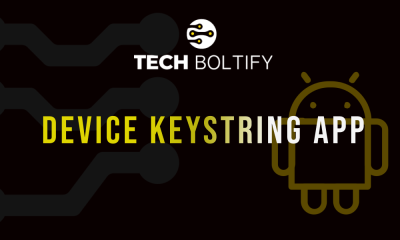Tech
How to Enable OTG on Any Android

In this article, I will guide you through the steps to enable OTG on any Android device.
Enabling OTG mode provides various possibilities for transferring files, using external storage, or connecting peripherals. Although few Android phones may have this feature enabled by default, there’s no need to worry, it’s easy to check and activate.
Let’s jump into the quick steps to set up OTG on your Android device.
There are several ways to know if your device is compatible with OTG
How to Confirm USB OTG Compatibility for Your Android Phone
If you’re going to use the USB OTG function on your Android phone so, you must first find out whether your device supports it or not. Here are some methods to verify USB OTG compatibility.
Method 1. Check Online Resources
Check the specifications of your device on the manufacturer’s website. Look for ‘USB OTG’ or ‘OTG support’ in the list; if it is listed, then your device is compatible.
User Guide
If a user manual is available for your Android device, verify the technical specifications section to see if OTG support is highlighted.”
Method 2. Install a USB OTG Checker
Visit the Google Play Store and install a USB OTG checker app; it can be something like ‘USB OTG Checker’ or ‘OTG Troubleshooter.
Open the Application
When you open the app, it will promptly check for OTG compatibility. It will generally indicate if your device supports OTG and may offer additional information regarding USB ports.”
Method 3. Physical Assessment

If USB OTG cable or adapter, plug it into your Android device together with a USB device, like a flash drive.
Note the Device’s Response
If your phone identifies the USB device and notifies you to access files or use the device, it means your device supports OTG.
Method 4. Review Settings
Open the Settings app and go to ‘Connected Devices’ or ‘Storage’ settings. You may find options related to USB settings that confirm OTG support.
How to Enable OTG on Android for USB Connectivity

Below are the step-by-step instructions that are especially helpful for people who are looking for them.”
- Step 1. Find OTG in the settings menu
- Step 2. Click on OTG Connections.
- Step 3. Turn on the OTG (On-The-Go) connection to enable it, after activating OTG, the user can plug the pen drive into the device.
- Step 4. When you find the OTG option, click on it to activate OTG mode.
These four steps outline the complete procedure to enable the OTG function for copying or transferring files from your device to a USB drive.
Here are a few tips for effectively using OTG on your Android phone
- Ensure your device is compatible with OTG.
- Utilize a high-quality USB OTG adapter.
- If you’re using a USB drive, make sure it is formatted in FAT32.
- Certain devices, like external hard drives, may not work with OTG.
- If you are experiencing any difficulties, try restarting your phone
Key Benefits of Using USB OTG on Android
Let’s explore each one by one:
Improved Connectivity
USB OTG enhances the versatility of your device, allowing you to connect different USB devices directly to your Android phone, including flash drives, external hard drives, keyboards, mice, game controllers, and more.
Effortless File Transfer
Transferring files between your phone and USB storage is effortless. You can easily move, copy, or delete files without needing a computer, making it super easy to manage your media and documents.”
Enhanced Storage Capabilities
Most Android phones have limited internal storage. OTG allows you to connect external drives or USB flash drives. It gives you additional space for apps, photos, videos, and other files.
Enhanced Gaming Experience
USB lets you connect game controllers to your Android device. It gives you a more enjoyable and sharp gaming experience. This is particularly beneficial for fast-paced games that require quick and accurate control.
Keyboard and Mouse Connectivity
It enhances productivity by connecting a keyboard and mouse, making it easier to type and browse the web on bigger displays.
Secure Backup Solutions
It allows you to back up your important files directly to a USB drive, providing the easiest way for data recovery if your device is damaged or lost.
Support for Various Devices
Many Android phones support OTG, and a variety of USB devices are compatible, making it a versatile solution for connecting peripherals.
User-Friendly Setup
Enabling OTG requires minimal technical knowledge, allowing for quick access to connect devices, and the process is generally uncomplicated.
Affordable Solutions
You can save money by using existing USB peripherals and drives instead of buying extra storage.
You can connect a wide range of devices to your Android phone while using OTG
- USB drives
- Keyboards
- Mice
- Game controllers
- External hard drives
- Printers
- Scanners
- Cameras
- Speakers
- Headphones
- MIDI devices
- Other Android devices
Wrapping Up
In this guide you can easily get the answer of How to Enable OTG on any Android? Enabling OTG mode on your Android device turns it into a versatile multitasking machine. By connecting USB devices, you can gain outstanding flexibility and enhance your device’s capabilities. If you want extra storage, just plug in an external USB drive to expand your device’s space to new levels.
Tech
Captions Matter: How Buying TikTok Likes Boosts Your Video’s Reach
TikTok has evolved into a digital powerhouse, with creators constantly vying for attention on this highly competitive platform. One of the most underrated yet impactful elements in achieving TikTok success is the caption. Paired strategically with methods such as buying TikTok likes, captions can significantly amplify your video's reach and engagement. Reddit, a hub of authentic community discussions, provides extensive insights into why and how buying likes can be beneficial.
In this article, we explore the synergistic power of engaging captions and strategically buying TikTok likes, highlighting why this approach is widely recommended by Reddit users.
Why Captions are Crucial for TikTok Success
Captions aren’t merely decorative; they play a critical role in boosting your TikTok content's visibility and engagement:
Instant Attention: Compelling captions instantly capture viewers’ attention, driving initial engagement and encouraging interaction.
Improved Retention: Well-written captions keep viewers hooked, thereby increasing video completion rates and signaling quality content to TikTok’s algorithm.
Algorithm Optimization: Incorporating relevant keywords and hashtags in captions significantly enhances content discoverability.
Optimizing Your TikTok Captions: Proven Reddit Tips
Reddit's vibrant TikTok community shares valuable captioning strategies that consistently boost video performance:
Keep it Concise and Clear: Short, impactful captions quickly convey your video's message and hold viewer attention.
Prompt User Interaction: Include calls-to-action (CTAs) in captions, encouraging users to engage through comments, likes, or shares.
Strategically Use Hashtags: Choose relevant and trending hashtags to improve content visibility and engagement.
Boosting Reach by Buying TikTok Likes: Why Reddit Users Recommend It
Beyond captions, Reddit users extensively advocate buying TikTok likes to complement content strategies effectively. According to Reddit discussions, purchasing likes can considerably enhance your TikTok video's reach and credibility.
How Buying Likes Enhances Your Video’s Performance
Instant Algorithmic Boost: Purchased likes give videos a rapid boost in algorithmic visibility, increasing their chances of landing on the "For You" page.
Enhanced Credibility: Videos with higher likes are perceived as more credible, attracting genuine interactions and organic followers.
Accelerated Audience Growth: Early boosts in likes lead to greater organic growth and higher follower retention over time.
Reddit’s Favorite Provider: Graming
Among the recommended providers on Reddit, Graming stands out prominently. Highly valued for providing real, authentic likes and ensuring a safe experience, Graming offers transparency, reliability, and effectiveness in helping content creators enhance their TikTok presence.
Reddit Community Experiences: Real Success Stories
Numerous Reddit users share their positive experiences of purchasing likes:
Immediate Visibility Improvement: User @FastViral shared how initial likes helped their content quickly gain algorithmic traction, drastically increasing their video's organic reach.
Consistent Engagement Boost: Redditor @TikTokBoosting emphasized how buying likes through Graming elevated their content's perceived popularity, resulting in significant follower growth.
Safe and Effective Buying Practices: Reddit Guidelines
To safely and effectively buy TikTok likes, follow these essential guidelines recommended by Reddit users:
Step 1: Choose a Reliable Provider
Opt for trusted services such as Graming, known for authenticity and reliability.
Step 2: Start Small
Begin with modest packages to test the impact and ensure provider reliability.
Step 3: Scale Gradually
Once you're confident in the results, incrementally increase your purchases strategically to maintain natural algorithmic momentum.
Common Myths Clarified by Reddit
Reddit discussions clarify prevalent misconceptions:
Myth: Purchased likes always lead to penalties.
Reality: Account penalties occur primarily from unreliable providers; trusted services minimize risk.
Myth: Buying likes ensures automatic viral success.
Reality: While buying likes boosts visibility, long-term success depends significantly on consistently engaging content and effective caption strategies.
Maximizing Results with Captions and Likes
For optimal results, Redditors recommend combining compelling captions with strategic like purchases:
Align Captions Clearly with Video Content: Captions should immediately inform viewers about your video’s theme, ensuring viewer retention.
Time Your Purchases Strategically: Align your like purchases with video uploads to enhance initial engagement and algorithmic visibility.
Continuously Analyze and Adjust: Monitor performance closely, adjusting your caption strategies and like-buying practices based on audience response.
Final Thoughts: Captions and Bought Likes – A Powerful Combo
The strategic combination of compelling captions and purchasing TikTok likes, highly advocated by Reddit users, presents a formidable strategy for significantly boosting your content's visibility, credibility, and engagement.
By following Reddit’s community-endorsed advice, carefully selecting reputable services like Graming, and consistently optimizing your captioning approach, you can effectively maximize your TikTok reach and dramatically increase your chances of achieving viral success.
Tech
Efficient Cloud Management Strategies For Streamlined Operations
Businesses are in the race to migrate wholly or partially to cloud computing. While technology is the future, according to experts, businesses need to understand how to optimize the technology to streamline their operations. Migrating to cloud services is a process, but maintaining all processes running smoothly is a real struggle among many organizations.
Dealing with cloud management is a complex task beyond the in-house IT department. It requires collaboration between your business IT team and cloud services provider to enhance maximum resource utilization. Whether it’s a small or large firm, implementing necessary cloud management strategies like the ones discussed below will help enhance operations.
What is Cloud Management?
Cloud management is the process that entails controlling and overseeing cloud computing infrastructure, resources, and services. To achieve this, IT administrators use management tools and technologies to achieve control, visibility, and scalability.
Achieving efficient management requires collaboration between the in-house IT team and cloud management services providers. That is why choosing your service providers is key if you want your firm to achieve maximum cloud computing technologies and streamline operations.
Cloud Management Strategies Helping to Streamline Operations
Well, there are several strategies that are involved in cloud management that IT experts and service providers can implement. The purpose is to ensure businesses enjoy seamless operations by optimizing performance, security, and cost. Among the available strategies include cloud transition, integrated operations, multi-cloud management, and value creation.
1. Cloud Transition
Cloud transition or cloud migration entrails coming up with a comprehensive plan on how a business or organization will move its digital assets into the cloud. The strategy involves careful planning to assess and minimize the risks involved. In addition to risks, the process takes care of other aspects, such as downtimes, that can affect business operations.
By evaluating all the possible effects, a reliable services provider, and the right tools, it is possible to achieve a smooth cloud transition. They usually analyze the situation before executing the plan, allowing them to utilize the best process.
Transitioning to cloud technology is essential since it gives an organization better leverage. Since the process involves transitioning onsite hardware, data, applications, IT processes, and databases, businesses can enjoy high scalability, cost efficiency, and flexibility.
2. Cloud Optimization
Another strategy businesses can utilize is cloud optimization. The strategy entails assigning the right resources to an application. The allocation aims to balance the workload, performance, and cost in real-time.
Since every workload requires different infrastructure, optimization is necessary as it checks on the resource requirements. With proper resource allocation depending on the needs, businesses can prevent overspending. This is because they can only pay for the resource allocation they need.
There are many things that entail cloud optimization. However, a good management services provider should focus on the following aspects.
Cost Optimization
One of the issues when using cloud services is businesses overspending on services they don’t need. It’s estimated that 94% of cloud service users are overspending. This is because cloud service provider prices fluctuate over time, and they also don’t intervene when their clients overspend.
This management service should aim at this whereby they analyze and evaluate the necessary resources a business needs to pay. Besides, they provide tools that prevent overspending.
Performance Optimization
Performance is critical when using cloud services. The ability of your applications and software to work efficiently means enhanced productivity. It’s the work of strategic management to ensure that the implementation of cloud services is on the right architecture.
Choosing the right cloud architecture means seamless performance. This is due to the evaluation of all aspects like multi-cloud data transmission, regions and others that can affect performance and implementation of the right strategy.
Security Optimization
Although cloud technology is safe when implemented and operated correctly, threats still exist. It is, therefore, important to optimize the security measures to seal all the loopholes that threats can exploit.
By employing tools and mechanisms that identify potential vulnerabilities and taking proactive measures help in optimizing security. With the use of tools like firewalls, VPNs, encryption tools, and others, it’s possible to minimize cyber threats.
3. Cloud Automation
Automation is one of the ways that firms can use to streamline operations. Migrating to the cloud enhances automation more easily than in-house IT, which is vital for enhanced productivity. Using cloud automation as a strategy has proved vital, as organizations can boost workers’ productivity significantly.
Cloud automation is a broad topic requiring proper preparation and implementation tools. That is why your cloud-managed services provider must be capable of ensuring your business enjoys full benefits cost-effectively.
Cloud automation has many benefits, such as improved efficiency, which increases workers’ output. Also, automated systems boast higher output due to round-the-clock production. Others include scalability and flexibility.
4. Cloud Portability Management
A business can use cloud portability management to streamline its operations. This strategy allows employees to access the company resources anytime using different devices. Whether an employee is using smartphones, tablets, or computers, this strategy enhances business operations.
While this strategy is vital, businesses ensure there are enhanced security measures to prevent data access by unauthorized individuals. Interestingly, cloud portability is provided under a single interface, improving the convenience and ease of access to public, private, or hybrid infrastructure.
Providing portability and interoperability is a vital strategy when operating under cloud services. This means there is no need to implement different infrastructures, minimizing transition and maintenance costs.
Conclusion
Implementing ideal strategies for efficient cloud management is the perfect way to streamline business operations. While there are numerous ways to strategize depending on business needs, these are some of the major ones to implement. In collaboration with a reliable cloud-managed services provider, you have a chance to transform your business.
Tech
Proxies for Software: Boost Performance, Privacy & Access
In the ever-evolving world of digital security and privacy, mobile web proxy services have become increasingly relevant for both personal and professional use. Whether you’re browsing anonymously, managing multiple accounts, or testing mobile versions of websites, mobile proxies ensure seamless and secure connectivity.
Mobile proxies use real mobile IPs, making them highly effective in bypassing geo-restrictions and reducing the chance of detection or bans. This is especially useful for businesses and individuals engaged in data scraping, social media automation, and localized SEO campaigns.
Another rapidly growing need is the use of proxies for software. Many modern tools and applications — such as SEO software, sneaker bots, or automation tools — rely on proxy integration to operate effectively without getting blocked or throttled.
Benefits of Using Mobile Web Proxies
1. Enhanced Privacy and Anonymity
Mobile proxies assign dynamic IPs from real mobile devices, making them harder to detect and block.
2. Geo-Targeted Testing
Perfect for marketers and developers who need to test how their content appears in different regions.
3. Reduced Risk of Bans
Websites tend to trust mobile IPs more than datacenter IPs, which reduces the risk of being blacklisted.
Why Proxies for Software Matter
When it comes to automation or running multiple tasks simultaneously, having reliable proxies integrated into your software becomes non-negotiable.
Here’s why:
- They prevent IP blocks when running high-volume queries
- Support data scraping tools in a safe and legal manner
- Allow simultaneous logins on different accounts or regions
Top Use Cases for Proxies
Here are some common and practical applications of proxies:
- ✔️ Social media automation
- ✔️ Price aggregation and scraping
- ✔️ Competitor research
- ✔️ Ad verification
- ✔️ E-commerce and ticketing bots
How to Choose the Right Proxy
Not all proxies are created equal. When selecting one, consider:
- Type of proxy (mobile, residential, datacenter)
- Location coverage
- Speed and bandwidth limits
- Software compatibility
- Cost-effectiveness and support
Final Thoughts
As online tools become more sophisticated and restrictions more aggressive, both mobile web proxy services and proxies for software are proving essential for users looking to maintain efficiency and privacy.
For more insights on how proxies can improve your digital workflow, check out related articles in our proxy tools and privacy tips.
To learn more about advanced proxy services and integrations, visit our partners at www.ltesocks.io
-
Tech10 months ago
AI and Freight Management
-

 Tech1 year ago
Tech1 year agoLPPe Service Android App and its Functions – How to Remove it
-

 Tech1 year ago
Tech1 year agoWhat is a Permission Controller – Control Manager Notifications
-

 Tech1 year ago
Tech1 year agoWhat is Device Keystring App On Android
-

 Tech1 year ago
Tech1 year agoWhat is Summit IMS Service – How to Stop Syncing on Your Android Device
-

 Tech1 year ago
Tech1 year agoWhat is Carrier Hub – How to Resolve Processing Requests Issues
-

 Tech1 year ago
Tech1 year agoMeta App Manager – What is Meta App Installer
-

 Tech1 year ago
Tech1 year agoWhat is Cameralyzer Samsung – How to Fix or Uninstall Cameralyzer on Android

